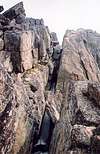|
|
Route |
|---|---|
|
|
48.98920°N / 120.189°W |
|
|
Scramble |
|
|
Half a day |
|
|
Class 3+ |
|
|
Overview
This is the easy way up the mountain. It is an enjoyable scramble with two minor Class 3+ bits and one Class 4 step-across. It is also the route of choice for descending the mountain after climbing up via either the Southeast or North faces.
There is a long chasm that cleaves the summit rocks into a south section and a north section. In early season this chasm is filled with snow making the first of two step-acrosses easy or easier. The second step-across has no benefit of snow in the hole. It's easier than it looks but still a knee-rattler. Other than that, the scrambling is fairly easy though there are some places where friction hoists are necessary to get over a block.
Approach Slope
From Upper Cathedral Lake (7,380 ft), take the trail for 0.6 miles nearly to 7,600-ft Cathedral Pass. Leave the trail and climb up easy, sandy terrain for several hundred vertical. Aim for the obvious notch (obvious if it's not socked in) on the West Ridge. It should take only 20-30 minutes to get to just below the notch from the trail. You do not need to go all the way to the notch. Instead, look for a broad ledge that leads around a spur shoulder to the right. This ledge is maybe 50 feet below the notch.
Summit Scramble
The other (east) side of the spur shoulder eventually falls away to a chasm marking the west edge of the Southeast Face. Scramble up the spur until the easy ground gives way to large blocks. This is where the Class 3 scrambling begins.
The idea is to move up and right as necessary over blocks and through small notches. Some routefinding is required but it should be easy to back-up if need be. Eventually you will come to the west end of the aforementioned chasm. Looking along the chasm to the right (east) you should be able to see the true summit. It is not really possible to stay on rock to the south of the chasm because the Southeast Face falls away abruptly there, making the scrambling difficult. You have to cross the chasm then re-cross it a few minutes later.
There are several places one can make the first chasm crossing. The west end may harbor snow that can be stepped on. This will lead to a series of ledges running right. Class moves to get into and out of the chasm when the snow is present. I don't know about later in the season. To the right (east) a short distance there is a lower point for crossing that could be easier.
Once across, scramble up to the top of the rocks comprising the north side of the chasm and then work right over slabs to the second crossing of the chasm. At first blush it looks spooky but the actual technical moves are easy (unless glazed over with ice). The gap is about three feet wide and drops around 50 feet. You don't want to fall in the hole.
There is a chockstone just to the right of the easiest spot to cross. The south side of the gap is 3-4 feet above the level of the north side, meaning you have to climb up as you cross. There should be a good foothold and a good handhold with which to make a fluid quasi-mantle move. After you get across you'll wonder why it scared you so much. Were it not for the exposure it would be Class 3. But the exposure makes it Class 4- in my book.
The summit is now a short, slabby scramble away.
Time = 2 hours (or less) from Upper Cathedral Lake; Gain = 1,200 ft.
Descent
For the descent reverse the route. Unless you have weak knees (and even if you do), it is probably best to simply jump back across the chasm since it is downhill (by 3-4 feet) to the other side. Trying to downclimb it then step backward across seems like it would be cumbersome.
Essential Gear
Some scared parties may wish to bring a short scramble rope for the chasm crossing(s). Other than that, no technical gear needed. Rockfall isn't a huge problem.
Take warm clothing. It can snow at any time of year in the Pasayten.






